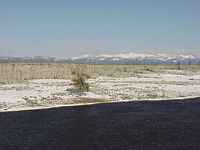
More of the Centennials.
What a crystal clear morning it was! Kilgore is approximately 6,325 feet in elevation.
I used the local gravel roads until I found the wide spot in the road called Kilgore (about 8 houses). I drove all over the area looking for the Camas Meadows Battlefield. There was a small US forestry building here which had a topo map, but the site was not on it. The ranger drove up, and I asked him if he knew where it was. He said he thought it was a few miles away somewhere in the lava fields, but he did not know exactly where (he was a forestry guy, not a historian). I decided to try the only road I had not driven on, and about six miles away (County road A2) there was a small, faded sign marking the battleground. I knew about this battle because of my research. I had seen one sign on a website several months ago. It was obvious that few people ever visited this place. It is not listed on any maps. If you want to go by, let me know and I will give you directions.

The seldom seen, or visited, Nez Perce Camas Meadows Battlefield, east of Kilgore, Idaho.
The entry from my book for August 20, 1877: "Nez Perce captured 100 mules from General Oliver Howard’s command at Camas Meadows, Idaho. Private Wilfred Clark, Company L, Second Cavalry, would be awarded the Congressional Medal of Honor for his actions today and August 9 at the Battle of Big Hole (Montana). Captain James Jackson, First Cavalry, would also be awarded the Congressional Medal of Honor for retrieving the body of his trumpeter while under heavy fire. Company L Farrier William H. Jones would also receive the Congressional Medal of Honor for his gallantry during today’s action and for his efforts in the battle of May 7, 1877, against the Sioux. Lieutenant H. M. Benson and six soldiers were wounded."

Back in Yellowstone! I saw bison (OK, buffalo), Wapiti (OK, elk), moose, coyotes, a wolf, a couple of bald eagles (no pictures - darn it!) and a few other critters. My previous visit here (the only place I had been before on the entire trip) was during the latter part of the fires of 1988. It was interesting to see how the lodgepole trees were growing back in the places which had burned (a part of the natural cycle). .















